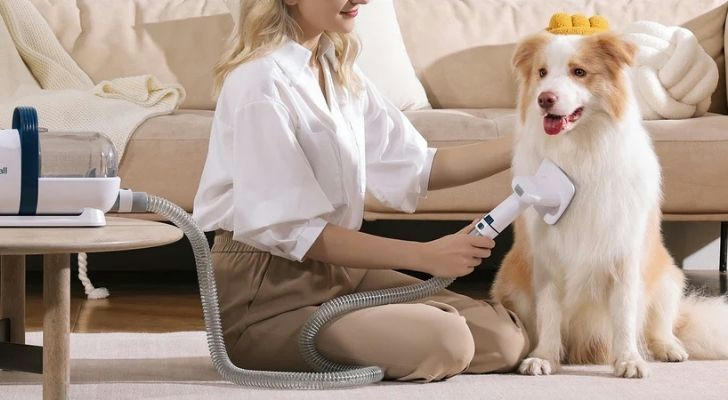Pet Grooming Goes Beyond Bathing: 5 Essential Steps to Full-Body Care for Your Furry Friend
When it comes to pet grooming, many people think it’s just about giving their furry friends a bath. While baths are a crucial part of grooming, there's so much more involved to keep a pet looking and feeling their best. Pet grooming is a holistic approach that encompasses various aspects of their health, comfort, and hygiene. Here’s a step-by-step guide to comprehensive pet grooming that goes beyond the basics.

1. Brushing for a Healthier Coat 🧑🔬
Brushing isn’t just about keeping your pet’s fur shiny and clean. It’s a vital grooming step that promotes healthy skin and fur, reduces shedding, and prevents tangles. Regular brushing also improves blood circulation to the skin, which encourages the growth of strong, healthy fur.
For pets with long fur, brushing should be done at least three times a week. Short-haired pets benefit from a weekly brushing session. Did you know that brushing can reduce shedding by up to 90%? According to the American Pet Products Association (APPA), over 60% of dog owners say they brush their pets at least once a week.
Tip: Use the right brush for your pet's coat type. A slicker brush works best for long-haired pets, while short-haired breeds may only need a simple bristle brush.
2. Ear Cleaning to Prevent Infections 👂🧴
Ear cleaning is often overlooked in pet grooming, but it’s crucial for preventing infections and discomfort. Pets, especially those with floppy ears, can accumulate moisture and dirt in their ear canals, creating the perfect breeding ground for bacteria and yeast. Untreated ear infections can lead to pain and hearing loss.
To clean your pet’s ears safely, use a veterinarian-approved ear cleaner and a cotton ball. Gently wipe the outer part of the ear canal to remove any debris. It’s essential to check for signs of infection, such as redness, bad odor, or excessive scratching. If you notice any of these signs, a vet visit may be necessary.
Tip: For pets with long, floppy ears, check their ears more frequently and clean them at least once a month to prevent infections.
3. Nail Trimming to Avoid Discomfort ✂️🐾

Nail trimming might sound simple, but it can be a delicate process. Overgrown nails can cause discomfort, affect your pet’s gait, and even lead to joint problems over time. Regular nail trimming is essential for your pet's overall health, especially for indoor pets that don’t wear down their nails naturally.
Aim to trim your pet’s nails every 2-4 weeks, depending on how fast they grow. A good rule of thumb is if you hear your pet’s nails tapping on the floor, it’s time for a trim. When trimming, avoid cutting too close to the quick, the pink part of the nail, as it can bleed. If you’re unsure, a professional groomer can help.
Tip: Keep treats on hand to reward your pet after a successful nail trimming session. This helps them associate the process with something positive.
4. Dental Care for Fresh Breath and Healthier Teeth 🦷🐶
Oral health is often ignored, but it’s one of the most important aspects of grooming. Poor dental hygiene can lead to bad breath, gum disease, and even heart and kidney problems. Studies show that 80% of dogs over the age of three have some form of dental disease. This makes regular dental care a must.
Start by brushing your pet’s teeth with a toothbrush and toothpaste designed for animals. Do this at least 2-3 times a week. In addition, dental chews and toys can help reduce plaque buildup and freshen their breath. Some pet owners also use water additives that fight plaque and tartar.
Tip: If your pet resists tooth brushing, try starting slowly with just a finger brush and gradually move to a full toothbrush.
5. Regular Health Checkups for a Happier Pet 🏥🐕🦺

Lastly, grooming isn’t just about aesthetics; it’s about overall health. Routine health checkups are an essential part of keeping your pet in top shape. Regular visits to the vet help catch any potential issues early, from skin problems to more serious conditions like parasites or infections.
During a grooming session, take the opportunity to check your pet’s skin for any unusual lumps, bumps, or signs of irritation. Watch for signs of fleas or ticks, and examine the paws for injuries or infections. Keeping track of your pet's weight and overall condition is also important, as obesity is a growing issue in pets.
Tip: Make an appointment with the vet at least once a year for an annual wellness checkup to ensure your pet stays healthy.
Conclusion 🌟🐾
Pet grooming is so much more than just a bath. By following these five essential grooming steps—brushing, ear cleaning, nail trimming, dental care, and health checkups—you’ll be giving your furry friend the best care possible. A well-groomed pet not only looks good but feels great and stays healthier longer.
Pet grooming can be a fun bonding activity and a way to show your pet how much you care. Don’t forget, consistency is key to maintaining a happy, healthy pet. By staying on top of grooming, you’re ensuring your pet lives its best life!
